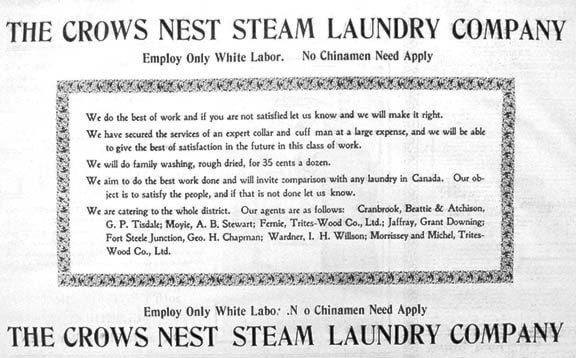Jim Cameron
The quest for gold brought people of all nations to British Columbia, as did the construction of the railway. Of all the labourers it was often the Chinese who worked the longest hours in the most dangerous conditions for the least money, creating great resentment among the white labourers.
When the gold ran out and the railway was complete there was little left choice but to put down roots and try to eke out an existence. In Cranbrook, the steadily increasing Chinese population, unable to vote and with no political representation, found themselves living in cramped, segregated and often unhealthy conditions, shunned by the majority of the white population.
Well, not completely shunned: the Chinese were hired at cut-rate wages for menial tasks. Chinese businesses appeared across from the CPR station as early as 1899, the most common being the ubiquitous laundry which, though frequented by the local white population, was often viewed as suspect.
Although Cranbrook grudgingly accepted an ever-growing Chinese population, many neighbouring communities simply drove the Chinese out of town. This further increased the local Oriental population which further aggravated occidental/oriental relations.
The Chinese found themselves confined to a two block radius along Van Horne Street: three-story residences, boarding houses, gambling houses, opium dens, restaurants, shops and "joss houses" (places of worship) soon created a wall-to-wall town within a town.
Newspapers of the day carried running commentaries on the menace of the "celestial" hoards, the heathens, and the yellow devils. Still, the Chinese slowly but surely became an integral part of the community. Local white contractors found work constructing Chinese stores and houses, realtors made commissions on land sales, shoppers browsed the Oriental bazaars for exotic knick-knacks and local chefs counted on the Chinese farmers for their supplies of fresh vegetables.
As B.C. mines and lumber companies began employing Chinese labour so did immigration increase, despite the $100 per individual "head tax" each Chinese immigrant was required to pay.
The first "white laundry" opened in town in 1904, promising "all work free of germs and filthy water." It was a hopeful claim at best, considering the general condition of Cranbrook's water and sewer works at the time, but "white only" became a selling point for businesses in the community and would remain so for decades to come.
Early 1905 brought the smallest hint of the beginning of a perceptible public shift in attitude towards the local Chinese. Editor F.E. Simpson, of The Cranbrook Herald, a publication very vocal in its anti-Chinese stance, stated, as regarded the recent Chinese New Year, "The Chinese must start new year debt free. It would be a great thing for The Herald if a lot of its subscribers would follow in the footsteps the heathen Chinese."
A left-handed compliment to be sure but, shortly thereafter, another article noted, "Not long ago two very bad young chaps of town attacked an inoffensive Chinaman and gave him a bad beating. A Chinaman is a human being yet there are some young fellows who imagine they are privileged to throw rocks at a Chinaman whenever they get a chance. Such boys would beat a dog, a horse or abuse their mother and curse their father. They need a touch of the law."
It was by no means an endorsement of the Chinese community but, as far as human rights were concerned, it was may be viewed as a step in the right direction.

Pictured: An ad from the Herald December 6, 1906. Despite the obstacles, the Chinese gradually made headway block by block into the local business district.
The constant immigration of Chinese brokered much discussion in politics resulting in an increased head tax of $500 in 1907. That same year it was estimated (no-one appears to have canvassed Chinatown to find out exactly) that there were 413 Chinese in Cranbrook, somewhere in the area of 25 per cent of the city's population. "That is far too many for a town this size" said The Herald, though, to Cranbrook's credit, no organized effort was made to remove them.
The Chinese generally kept to themselves, although there were occasional altercations with the law. In 1905, two Chinese males decided to conduct rifle practice on Louis (1st) Street. They fired several rounds which generally missed the large target they set up but did manage to connect with the CPR freight shed at the end of the street. The building has since been moved to the north and, in connection to the Royal Alexandria Hall, forms the Cranbrook Historical Archives (Railway Museum). No doubt the bullets remain imbedded in the walls to this day. The riflemen were apprehended and fined $5.00 each, gunplay being somewhat more common then than now.
In 1906, police chief Baron raided a hop joint (opium house) conducted by Charlie Yo in Chinatown and seized two opium pipes, twenty dollars worth of opium and "the usual lamps & trays." Mr. Yo was fined $1.00, not because opium was illegal but because he had not paid for a municipal opium license.
Among the many bylaws brought into force during the incorporation of Cranbrook in 1905 was one that required opium sellers to obtain a license to sell opium at a cost of $250.00 for a period of six months (druggists and chemists were exempt.) In fact, it was not until 1908 that opium was banned in Canada, as were morphine and cocaine three years later. Until that time the opium dens of Chinatown were legal, but from that point on, in the eyes of the law and the good white folk of the city, the troubles truly began.
Next week: Chinatown.
